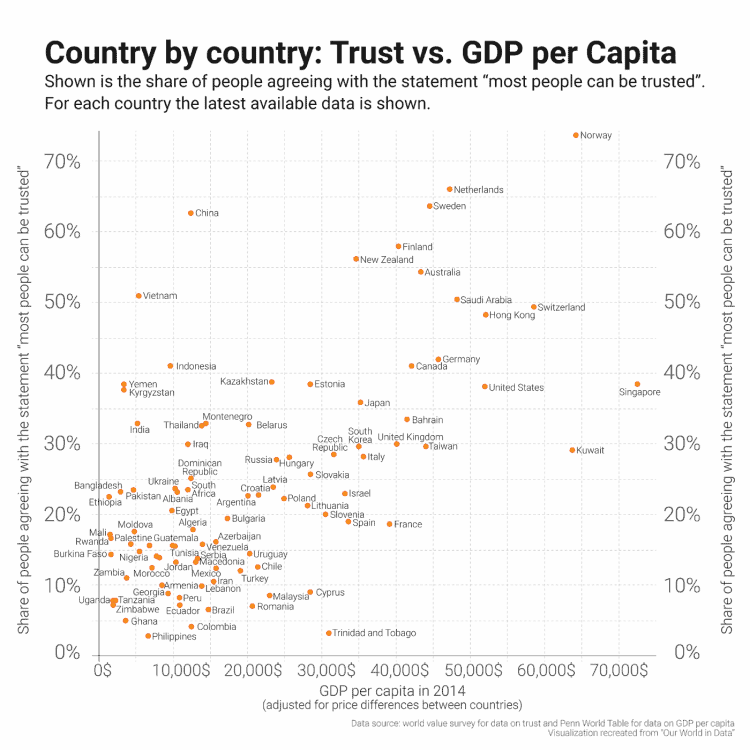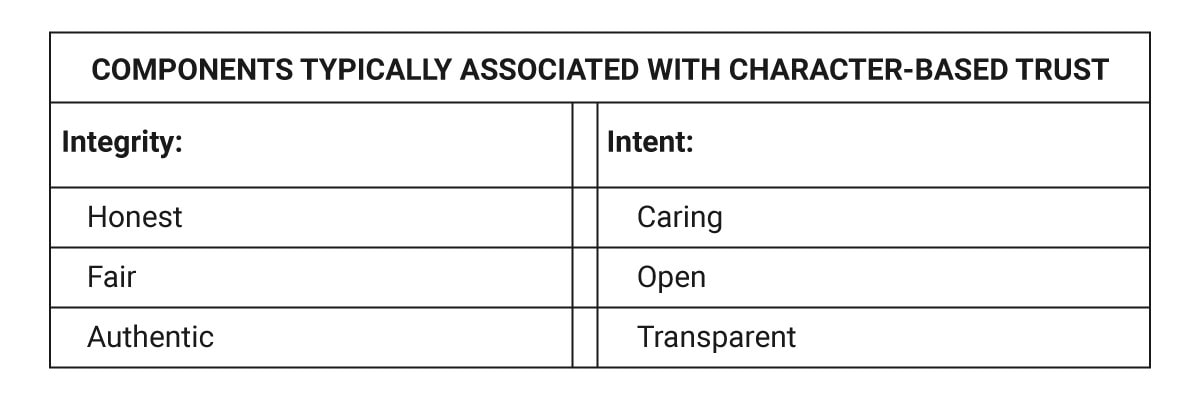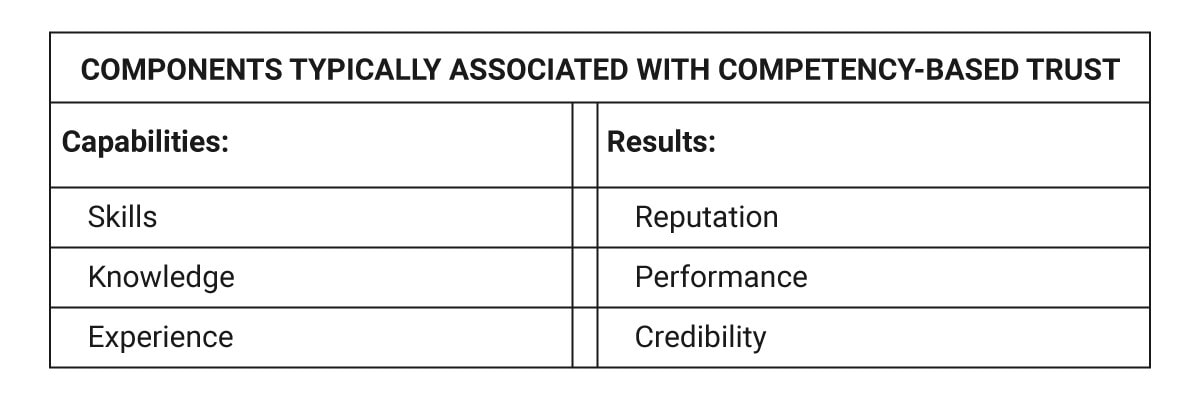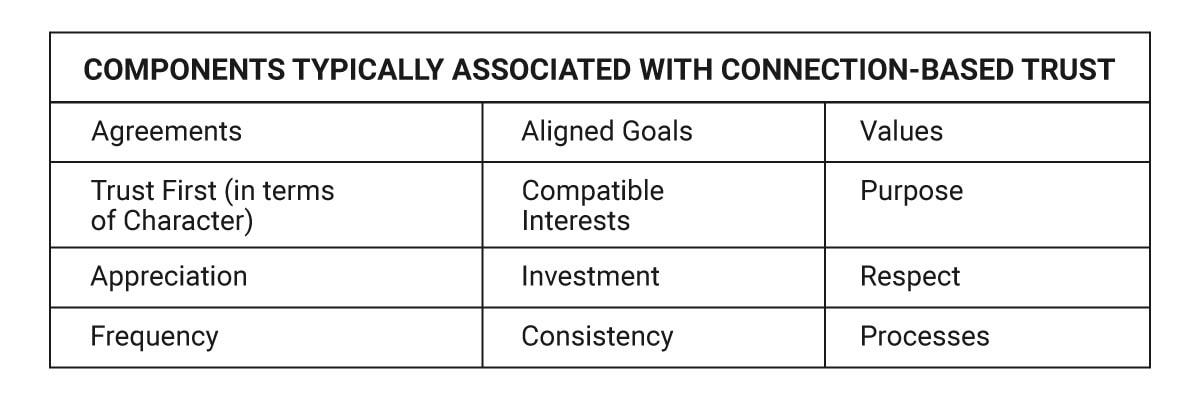Take even a short deep dive on the topic of trust and you’ll find thousands of related research papers, books, articles, and blogs. Dig into those materials and you’ll find trust is among the strongest indicators economists have to predict per capita income across countries. (See the chart below, which was originally created by OurWorldInData.org.) Why? Trust is the enabler of business. Without it, most market transactions would be impossible.

Trust doesn’t just help explain GDP per capita but the overall well-being of people, families, tribes, companies, communities and nations. Research makes it all but certain that the vast majority of highly successful organizations are High Trust Companies (HTCs) that have high-trust relationships with most, if not all, of their stakeholders:
- Customers
- Employees
- Senior Leadership Team
- Vendors
- Strategic Partners
- Investors, and their
- Communities
HTCs have, relative to Low Trust Companies (LTCs), stronger revenue growth, better margins, lower customer churn, less employee turnover, more innovation, better risk-adjusted returns on capital and healthier brands (i.e., more highly respected within their broader communities and / or society).
In short, trust is essential for a healthy economy which affords us the opportunity to Work, and together they make it almost easy to live a good life.
In short, trust is essential for a healthy economy which affords us the opportunity to Work, and together they make it almost easy to live a good life.
If trust is so obviously important, why doesn’t every society, government, company, group and individual make it “Job #1”?
In my opinion, there are a host of reasons including, but by no means limited to:
- It crosses a number of academic disciplines (e.g., neuroscience, biology, sociology, history, economics, finance, organizational behavior, psychology, and more).
- It’s complicated and challenging to measure at individual, team, department, inter-department, organizational and societal levels.
- It’s something we are still understanding better and better and the consequence of which we are building both a consensus and shared language around what trust is, how to measure it, and how to build and sustain it.
- It takes a tremendous amount of work and Work to build it and keep it (kind of like staying healthy), and the Work is never finished.
- A lot of our leaders are Low Trust People (LTPs) and we’re embarrassed and overly accepting of LTP, LTCs and Low Trust Leaders (LTLs).
- It implies that there is a hierarchy associated with levels of trust and hierarchical thinking, and hierarchy-based systems are not politically correct (coming in a future essay).
- It requires longer-term thinking and the vast majority of people are shorter-term focused (also coming in a future essay).
- Bad faith actors seem to get away with proverbial murder (so if they can, why can’t we?).
- Many so-called “elites” don’t believe we can collectively handle the truth.
- Many believe the ends justify the means.
- Many believe life is best played with a win-lose mentality.
- Many people like having an enemy.
- Way too many people are playing finite, short-term games.
- Many people don’t like to see their enemies win or give them credit for anything, even if they agreed or believe their competitor did the right thing.
- Technology is banging away at the organizational / economic / business models of a broad array of our institutions (like government, education, media) and those highly vested in the status quo deeply believe in their institutions and are afraid of the changes to come.
This list will grow…
What is Trust?
Enough of the big picture, fairly depressing stuff, for now.
Let’s go all academic for a bit…
One of the first comprehensive mathematical derivations of trust came from a 2001 biologically based model introduced by Paul J. Zak and Steve Knack. It showed that trust reduces the transaction costs associated with investment decisions by increasing confidence in what the other party would do. (Note how it was an analysis of Work through which we began to make serious strides on insights associated with life.) Since then, Zak has continued to not only develop his research on trust but write a series of research papers, contribute a number of articles to the likes of the Harvard Business Review, as well as publish The Trust Factor — a book I strongly recommend to anyone who is remotely interested in Work, relationships (aka well-being and life) and / or leadership.
The Biology of Trust
According to Zak: “Our human brain [has] two neurological idiosyncrasies that allow us to trust and collaborate with people outside our immediate social group (something no other animal is capable of doing). The first [of our neuro idiosyncrasies] involves our hypertrophied cortex, the brain’s outer surface, where insight, planning, and abstract thought largely occur.”
Our second neuro idiosyncrasy is our ability to share people’s emotions — aka empathy. Zak’s research revealed that our ability to empathize increases when our brain releases oxytocin. It appears that humans have more oxytocin receptors than any other animal. That is, our social nature is anatomically inscribed in our brains. Oxytocin not only reduces the anxiety we naturally have when we are around other people, but it also modulates dopamine, the brain’s “do this more” reinforcement chemical. Dopamine makes it feel good to collaborate and connect with others, which means that working together is something we have evolved to not only need but enjoy.
Trust, Purpose and Joy
One of the other insights Zak and his team has given us is the neuroscience around purpose. Zak’s associated research reveals that having a sense of higher purpose also stimulates oxytocin production. This makes sense to me because it is consistent with my belief that the purpose of life is to make life better, and that doing Work that is meaningful (especially doing it with other people we trust) is essential for scaling Maslow’s hierarchy of needs (i.e., moving to genuine, healthy, belonging; then on to self-esteem [making a difference]; and then on to self-actualization [i.e., finding joy in what we do]).
So what does it mean to trust someone? Over the years, I’ve come to believe (tough to use any other words given how fast we are developing research-based insights these days) there are multiple dimensions associated with trust, but if you want to make it super simple, there are three primary dimensions: Competency, Character and Connection.

As you may have noted in my prior essays, I love going big picture and then diving into the details. In terms of the big picture, I believe character-based trust became a big thing way, way long ago. As laid out in About Humans 101, this is the form of trust we developed way, way back when we were running around, pretty much naked and needing to figure out whether or not to trust someone given that, on the one hand, they could kill us; on the other, they could help us acquire food, protect our family, help us build a structure to not only protect us from the elements, but store and protect our food; maybe even teach us something; maybe do the stuff we don’t either like doing and /or stink at doing; provide solace when tough things happen; and heck, even make us laugh.
Character-Based Trust
So what is character-based trust? Character-based trust is all about integrity (e.g., honest, fair, authentic) and intentions: Do we trust the other person’s intentions and, more specifically, are those intentions in conflict with mine or my needs. A simple example is being approached by a stranger who appears intent on harming us. The form of harm could be physical, financial or emotional or some of all of these things (e.g., punch me in the face and take my car while my beloved dog’s in it).
Unlike competency-based trust, which is typically earned or awarded based upon a review of credentials, character-based trust is best assumed to exist. This is tough for a lot of people due to some form of prior life trauma and / or disappointment (future essay on stages of ego-development). Like it or not, the challenge with character-based trust is that, since trust is in part chemical, if we approach people assuming we cannot trust them, it actually makes it far more likely they will not trust us. It’s kind of like oxytocin gives us this innate “trust geiger counter” and the other person’s trust geiger counter goes off if our geiger counter is going off. This is part of the logic behind Ronald Reagan’s famous line “trust but verify.” I won’t go deeper on this today, but the research is pretty clear that people who insist others must prove trustworthiness spark distrust, not trust (if you want to go deeper, check out Douglas McGregor’s Theory X and Theory Y leadership concepts).

Competency-Based Trust
After we developed some confidence in our ability to assess whether we could trust someone’s character, I believe we then moved on to figuring out the competency-based trust thing.
In my opinion, competency-based trust likely became pretty important as we learned to “divide and conquer” and trust that others were capable of doing the things that we choose to rely on them to do. We made the choice to divide and conquer so we could do the things that we were not only good at doing but loved doing so much that we could see wanting to become even better and better at doing that thing. Becoming better at something is an innate Need, in my opinion, because becoming better at something (in particular, better at something that others value) helps us matter more and more to our tribe. This not only increases our sense of belonging but helps us develop and / or fortify our self-esteem.

While I obviously have no clue how this all unfolded, I wouldn’t be surprised if the third dimension of trust — Connection — didn’t start to be a thing until we kept trying to figure out why the heck we still didn’t trust certain people even if they seemed competent and we had no concrete reason to doubt their character. Fact is, I still think we are developing our ability to understand connection-based trust (more on this later in this series).
Connection-Based Trust
Connection-based trust is all about the non-competency, non-character things that keep us connected in a healthy way. They are a kind of bridge that makes the other two forms of trust relevant. If you’ll recall, I wrote a little bit about this in About Humans 101. These are all of the obvious things that not only attract us to one another, but make it easier for us to stay connected.

That’s a lot of stuff to think about and Work on, right? We won’t go much deeper into unpacking all the components of connection-based trust in this essay but we will go deeper on this in this series. For this essay, let’s just go a bit deeper into the values component.
As I wrote about in About Humans 101, values came into being as we became members of larger complex tribes. For years I believed / taught that trust was only about personal character and competency, but as I began to dig deeper into why some tribes didn’t / don’t get along, it became clear that oftentimes they just don’t trust the implications of the other tribe’s values. In fact, I would argue that this component of connection-based trust has become even more important for some, if not most people, than the other two dimensions. Let’s walk through a short analogy looking through each of the three lenses of trust before we get into why I think overweighting the values component of trust isn’t a particularly healthy thing for society (aka a collection of tribes).
Water…
Pretty important stuff. Something we cannot live without. When we drink it there is a huge amount of trust being exhibited.
First, there is the character thing: we trust it won’t harm us. That means we trust that no one has poisoned it and that it is both clean and non-toxic (whether we should or should not is a story for another day and there are many stories out there about water systems that people haven’t or shouldn’t have trusted).
Next up, we know we are going to need a dependable flow of healthy water so we are inherently trusting the competency of someone or something to bring it to us.
Finally, there are values: We trust that someone or something is not going to possess a set of values that somehow would make us insecure that we will continue to have access to healthy water. Examples of this form of trust issue could be that someone believes we should no longer have access to water if we say something or do something that they disagree with.
Mess with either of the character and competency dimensions and elevate the importance of the values dimensions and our trust in water, and our water supply, goes down the proverbial drain (sorry, couldn’t help myself).
We could go deep on every one of the connection components, but each is a whole essay on its own. (Note that several are forthcoming, including one on expectations versus agreements, which is something I learned in a coaching session with Steve Chandler [even coaches have coaches]; it’s one of the first things I teach my clients.)
It is very important that we understand that not only are there three dimensions of trust, but that one is “earned” (competency), one is “lost” (character) and one is “developed” (connection).
It is very important that we understand that not only are there three dimensions of trust, but that one is “earned” (competency), one is “lost” (character) and one is “developed” (connections).
While all three dimensions of trust are critical, my experience suggests that competency-based trust — especially compared to character-based trust — is fairly easy to ascertain. First, unlike character-based trust, we don’t have to just give it out (which is much easier said than done, especially if our trust has been violated in the past). Fact is, it is not only quite OK for it to be earned and / or proven, but should be (otherwise it’s often tantamount to throwing someone into the proverbial deep-end of the pool without knowing whether they can swim). Consequently, with a reasonable amount of work and skill, a good leader and / or coach is capable of ascertaining whether or not a prospective or current employee has the competencies necessary to properly discharge the duties associated with his / her roles and responsibilities.
Conversely, research reveals that, if we operate with the mindset that everyone has to earn our character-based trust, we will substantially reduce the likelihood that others will trust us because each party will sense that the other party doesn’t trust the other ( “tit for tat” may be one of our most basic instincts).
Finally, there is connection-based trust. One doesn’t need to dig into the headlines these days to see example after example where people will trust someone just because they are in their tribe regardless of whether they trust their character or have any sense for their level of competency. Painful examples are presented to us every day if we look for them. A timely example is our current political landscape where people trust people based first upon their shared values, even though the person they’re trusting, on a matter that requires deep expertise, has literally no subject matter competency; and those with even a mild amount of subject matter competency can tell that the person that is being relied upon has no clue what they are talking about. This is even worse if the real expert knows that the person ought to know better, so there may even be a not-too-small amount of bad faith being exhibited. But, since they share the same values or, more simply put, are in the same tribe, the subject matter expert casts a “blind eye” towards the transgression. IMO, in the United States, both of the mainstream parties have more than their fair share of culprits (aka scoundrels).
Trust is core to every relationship… and no leader nor company will go far without being trusted by the vast majority of its stakeholders.
I get the world is complex, but I hope we all agree it would be a far better place if subject matter experts called out the ignorant (or worse) for putting forth ideas that they know are bad faith just because they think it advances their cause. IMO, those who operate with the belief that they can act in bad faith as long as “the ends justify the means” have done serious damage to not just the trust between the two major parties in the United States but to the reputation of most of our major institutions, like virtually all branches of the government, the media and education. I’m not here to take on any of those institutions in this essay. What I am hoping to convey is that trust is core to every relationship, that it is three dimensional, that each dimension is important, and that no leader nor company will go far without being trusted by the vast majority of its stakeholders.
Executive Summary
- Trust supports the overall well-being of people, families, tribes, companies, communities and nations.
- Research makes it all but certain that the vast majority of highly successful organizations are High Trust Companies (HTCs) that have high-trust relationships with their stakeholders.
- Trust promotes stronger revenue growth, better margins, lower customer churn, less employee turnover, more innovation, better risk-adjusted returns on capital and healthier brands.
- One of the first comprehensive mathematical derivations of trust showed that trust reduces the transaction costs associated with investment decisions by increasing confidence in what the other party would do.
- Our social nature is anatomically inscribed in our brains…. Dopamine makes it feel good to collaborate and connect with others, which means that working together is something we have evolved to not only need but enjoy.
- It is very important that we understand that not only are there three dimensions of trust, but that one is “earned” (competency), one is “lost” (character) and one is “developed” (connection).
- Character-based trust is all about integrity (e.g., honest, fair, authentic) and intentions: Do we trust the other person’s intentions and, more specifically, are those intentions in conflict with mine or my needs?
- As we dig deeper into why some tribes didn’t / don’t get along, it becomes clear that oftentimes they just don’t trust the implications of the other tribe’s values.
- Trust is core to every relationship, that it is three dimensional, that each dimension is important, and that no leader nor company will go far without being trusted by the vast majority of its stakeholders.
Action Items
- Do work in a High Trust Company? Are there opportunities to increase one or more of the dimensions of trust across your organization?
- Can you increase the level of trust with your colleagues? Are there better ways, and / or should you create more opportunities to communicate and strengthen connections?
- Are your values aligned with those you Work with? If not, consider how that lack of alignment might impact your ability to Work together, your results, your business and your growth.
- Using the example of access to healthy water, a low trust company might create arbitrary restrictions (denying access) if a person says or does something others may reasonably disagree with. Is this helpful? Does this genuinely make life better? Are there areas of your business or relationships where that could happen? If so, look for ways to shift to a more humane, longer term oriented, approach.



